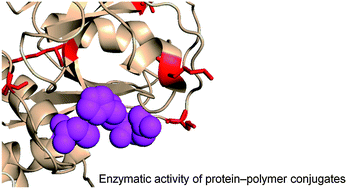Polymer–protein conjugates: an enzymatic activity perspective
Abstract

* Corresponding authors
a
Swiss Federal Institute of Technology Zürich (ETHZ), Drug Formulation & Delivery, Institute of Pharmaceutical Sciences, Wolfgang-Pauli Str. 10, HCl J 396.4, Zürich, Switzerland
E-mail:
marc.gauthier@pharma.ethz.ch
Fax: +41 44 633 1314
Tel: +41 44 633 7329
b École Polytechnique Fédérale de Lausanne (EPFL), Institut des Matériaux and Institut des Sciences et Ingénierie Chimiques, Laboratoire des Polymères, Bâtiment MXD, Station 12, Lausanne, Switzerland

 Please wait while we load your content...
Something went wrong. Try again?
Please wait while we load your content...
Something went wrong. Try again?
M. A. Gauthier and H. Klok, Polym. Chem., 2010, 1, 1352 DOI: 10.1039/C0PY90001J
To request permission to reproduce material from this article, please go to the Copyright Clearance Center request page.
If you are an author contributing to an RSC publication, you do not need to request permission provided correct acknowledgement is given.
If you are the author of this article, you do not need to request permission to reproduce figures and diagrams provided correct acknowledgement is given. If you want to reproduce the whole article in a third-party publication (excluding your thesis/dissertation for which permission is not required) please go to the Copyright Clearance Center request page.
Read more about how to correctly acknowledge RSC content.
 Fetching data from CrossRef.
Fetching data from CrossRef.
This may take some time to load.
Loading related content
